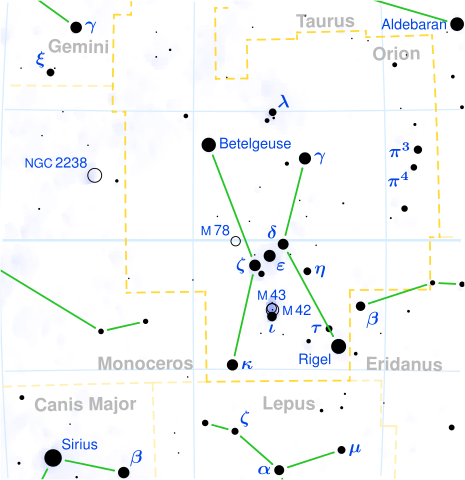Squish Like Grape
You are here
What's Up with Orion's Shoulder?
Primary tabs
Betelgeuse, formerly one of the ten brightest stars in the night sky, is behaving strangely. It might be about to explode into a supernova, or it may be just gas.

The star, which marks the right shoulder of the constellation of Orion, is a variable star, meaning its brightness varies over time. But never in recorded history has it dimmed as much as we've seen in the last few months. This is behavior consistent with the end of a star's life as it burns out the last of its fuel, but there are several other, less dramatic possibilities.
Betelgeuse is also a red supergiant. A supergiant is a star formed with more than 10 times the mass of our sun. It's massive enough to start burning hydrogen at a relatively early stage of development. It also burns through the hydrogen in its core relatively quickly. As the inner core is consumed, the outer shell expands. The result is a star much larger than the typical star. Betelgeuse is about 1400 times the size of our sun; if it were to replace the sun in the center of our solar system, all four terrestrial planets and the asteroid belt would be inside the star.
Supergiants have one other unique property. Because they burn their fuel relatively quickly, they are left with unstable cores that eventually collapse in an explosion that quickly pushes the outer layers much further out. The result is a supernova.
How soon will this happen for Betelgeuse? It's hard to tell. All signs indicate it's near the end of its life already, and won't last more than another million years. Sure, that's a long time for humans to comprehend, but in the span of universal history it's a blink of an eye. And that's the maximum time the star has left. At the other end of the spectrum, maybe it's already gone supernova. Betelgeuse is about 640 light years away from us, which means what we're seeing now happened about 640 years ago, around the year 1380. If what we're seeing is a genuine dimming of the star, that's when it happened. The star could have exploded at any time between then and now, and the light from the supernova could already be on its way here. Or we could be waiting a million years.
Or we could be seeing something else entirely. Astronomers researching the star's variability have found two oscillation cycles, one of about six years and one of about 425 days. There may be others we haven't identified yet. Some researchers think the cycles are reaching their minimum brightness (maximum dimness?) at the same time; if this is the case, we'll see a reversal within the next few months and everything will go back to normal.
Or perhaps the star isn't dimming at all. Maybe we're just seeing interstellar dust or gas obscuring our view of the star. Maybe it's even dust ejected from the star as part of the normal stellar life cycle. It's certainly not the first star to exhibit rapid extreme dimming.
For now, all we can do is keep watching. Orion will be visible in the night sky in most of the world through March, and in some latitudes can still be seen into May.
Theme by Danetsoft and Danang Probo Sayekti inspired by Maksimer


